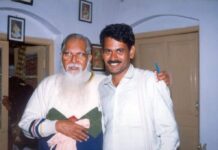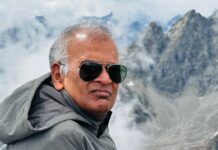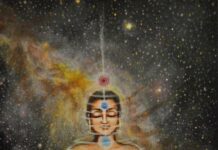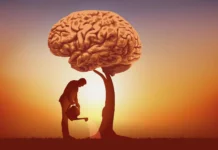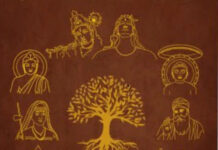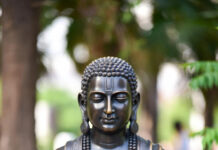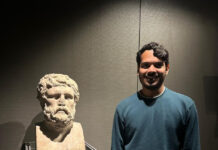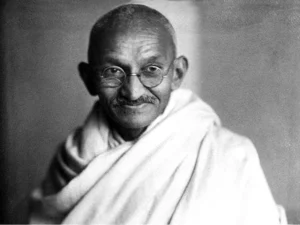
Dear Jeyamohan,
Your essay titled ‘Mohandas and Mahatma’ was suggestive of your disagreement with Gandhi’s approach to relationship between opposite sexes. I believe Gandhi was just advocating righteousness. How else could a person like Gandhi speak? What do you think is faulty in such a stance?
– Sivasubramaniam
Jeyamohan,
I am reading your essays on Gandhi with keen interest. What do you think about experiments relating to lust and passion that Gandhi conducted by sleeping next to young girls? Would you say that it is not wrong for Mahatmas to do so?
– Selvarajan
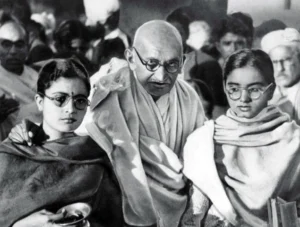
Dear Sivasubramaniam and Selvarajan,
Gandhi’s worldliness is oriented towards self-denial. Sex and love are related to self-blossoming. Hence, Gandhian vision is basically against love and sex, which is its greatest shortcoming.
In this aspect, Nitya Chaitanya Yati totally rejects Gandhi. When Nitya was in Gandhi’s Sabarmathi Ashram, a ‘complaint’ about a romance between a girl and a boy was brought to the notice of Gandhi. Gandhi made that girl stand up in the prayer meeting and conducted a public enquiry. He exhorted that control of one’s senses is a pre-requisite in the service of nation and ordered her to fast in atonement to wash off her sin.
Nitya describes the image of that girl, cringing in tears. It would have left an indelible scar in her mind. Her tender feelings would have become rigid. It might have induced her to indulge in negative activities or to withdraw from the society. But, for sure, she would have developed a permanent guiltiness about indulging in love and sex.
However the effects would have been completely different had sex been discussed in a transparent manner, devoid of any guilt. It is a moment when the soul gets liberated from the many obstacles that binds it within. But Gandhi conducted a public enquiry.
A similar incident took place in Nitya’s Gurukulam. Nitya’s friend, a young sanyasin named Vinaya Chaitanya, whom Natarajaguru had considered to be his successor, fell in love with a young lady who had come to the Gurukulam. The information reached Natarajaguru. After discussing with them, Natarajaguru solemnized their marriage with much merriment.
Gandhi could have counselled the girl in private. It did not occur to him, because, for those like him, who are puritanical, sexual feeling could be controlled only through pain and suffering. Hence, they would always try hard to control it by subjecting to extreme humiliation and sorrow.
Gandhi practiced it for self too. When he realized that he had committed a mistake, he conducted a public enquiry upon himself. He did not stop to think about the mental stress and agony it would create for others. As per Gandhi’s principle sex is grime. Removing it is self-cleansing. The best way to do it is to be straightforward.
Gandhi had inherited this attitude from two great traditions. One is Jainism and the other is Christianity. Jainism pictures lust as the first of the three inner grimes (Kama, Krodha and Moha). This wise tradition stressed that spirituality is opposed to lust and by being absolutely frank one can attain salvation from lust. That is the reason why the Jain Sanyasins stay undressed.
Only from India, the idea of renunciation of lust could have gone to the Greek tradition of renunciation. Jainism had its influence along all major trade routes. Its ideas could have reached Central Asia, Greece and Rome through the silk route. Gnostics believed that renunciation of worldly pleasures was the only way for spiritual satiation.
From them, this belief deeply penetrated into the Christian tradition. Even in Gnostic Christianity, which was an alternative to the Roman Church, renunciation was a spiritual way. Later, Roman Christianity accepted it. Asceticism became an authority in the Church.
Gandhi’s asceticism had its beginning in both these traditions and he chose control over his senses as his path. Undoubtedly, it gave him great strength. But Gandhi recommended it as an absolute way of life to his students and even tried to impose it as a stipulation for participation in the freedom struggle.
However, Gandhi’s disciples struggled to follow it and some of them started feeling intense guilt. Many of them, with their youthful vigour for ideals and expectations, adhered to celibacy. But middle-aged, married Gandhians struggled. M.O. Mathai, in his autobiography ‘Memoirs of the Nehru Era’, says that Morarji Desai was the only Gandhian, involved in politics, to believe in celibacy.
It is very difficult to handle lust, because it is a complex web of finer feelings and it has an elaborate traditional background. A strict approach to deal with it will end up in violence. Even tenderness arising out of good intention might create unexpected effects.
Nitya had narrated the experience of one of his classmates, who later became a famous Christian priest. This happened when he was seventy years old. A young nun was ensnared and caught red-handed while masturbating in the toilet and was presented before him. He spoke to her privately, advised her that it was a great sin and pardoned her.
But that girl slowly became a neurotic and later became mentally ill. That priest wrote to Nitya about this with much emotion. Nitya said, ‘That idiot should not have talked to her about it. It would have been different had she herself volunteered to talk to him. How can he trample her privacy?’ But the Jains, Buddhists and the Christians never understand these feelings. This is their greatest weakness.
Someone had related an incident almost similar to this. In the eighties, when the LTTE was becoming very active, a young man in its camp near Chennai was caught masturbating in the toilet by his comrades and was subjected to public enquiry. He was beaten up and punished. In those days, the LTTE had put forth celibacy as an important principle, a symbol of self-sacrifice. The Tigers might have acquired that attitude from two traditions that preceded them. One is Catholic Christianity and the other is Theravada Buddhism.
The idea of considering sex as something that is against dedication has been prevalent the world over. Hence, various institutions have created hardcore oppression by trying to control sex. There are so many complaints against the Catholic Church and the Eastern Buddhist Monasteries, which have established celibacy as a great principle.
In the tradition of Hindu wisdom, asceticism had always existed. Later it set up institutions of ascetic monasteries like those run by the Jains. But the tradition here is entirely different. If someone goes there to become an ascetic, he will stay there as a celibate and a student for many years. He will be closely observed and only if he was found to be naturally inclined towards asceticism, will he be granted it. In many instances, it could take as much as 15 years.
During this period, all his shortcomings would be considered as natural. 99 persons out of 100 would get married during this period and later continue to be a student with familial ties. Out of more than 2000 students who came to Nitya’s Gurukulam to become ascetics, only 18 succeeded.
A question might arise here. Why asceticism is considered so important in most of the religions? Is sex not as natural as hunger? Why should we deny something that is natural? By suppressing sex are we not distorting our minds, leading ourselves to psychic problems? Mostly it would be the Freudians who raise such questions as if all this is established truth.
The answer is that the sexual urge of man in the present, is not that which was originally given by nature. For today’s man sex is not similar to hunger. In the course of centuries, man’s sexual urge has been transferred from his body to mind. No other living being contemplates sex as incessantly as man does. Mind knows no boundaries as is man’s sexual urges. It swells within him. Actually, the sexual urge that is inherent in a common man is much more artificial than the act of controlling it.
Nothing is boundless in nature. The dialectics we see in nature is created by mutual control of one thing over another. A single grass, if unrestrained, would envelop the entire earth. Inside each and every living being lies the power to expand, spread, encroach, conquer and last forever. Only when its power is checked by that of another being, nature’s equilibrium is maintained. If there were only deer and no tiger, forests would have vanished and so also the deer.
When human sexual urge enters the mind it becomes boundless. The distance it could traverse is beyond imagination. The only antithesis that could exercise control over it is the body. The body is not omnipotent. Those who indulge in uncontrolled sex ruin their body prior to their mind, for lust becomes perverted when it goes astray.
Therefore, in every society, values have been created to control sexual urge. There are two forms. One is direct moral discipline. The other is modifying lust into glorified love and sublimating it. Human life maintains its equilibrium by conforming to these two disciplines. It remains natural only in this equilibrium.
If we consider sexual urge as natural and leave it uncontrolled, we would reach an extremely artificial phase, a stage where there is no natural life. If a dog behaves, as it would during the mating season, throughout the year, it would die of hunger. There will be no other thought in a mind that is full of uncontrolled sexual urge. It will have no life in any other plane. In our daily routine, we should possess a force to control our sexual urge. Most of us have it in us.
The next stage is renunciation of sex. When we dedicate ourselves to a noble cause, when all our activities are to be focused on it, we have to suppress our pleasures. It is said that sexual feeling should be suppressed as it is the foremost of all pleasures. One who cannot suppress it is not fit for missionary work. This applies not just to the Jain and Buddhist ascetics and Christian Missionaries, but also to the Communist leaders.
This is not possible for everyone. The intensity of one’s dedication decides it and it is very difficult to sustain it. When the impelling force of idealistic passion loses its tempo, sexual urge surfaces. This makes most of the religious and political activists, who practice celibacy at an young age, to return to family life in their middle age. It is quite natural.
The pinnacle of conquering sexual urge is Yoga. Knowing the ultimate truth is reaching the stage where the seeker vanishes slowly and becomes the knowledge itself. For this, one has to overcome the sexual urge, hatred and the desires within him. Otherwise he would be taking them as real and at the same time he would be aware that truth exists beyond.
We are unable to see the reality in all that we like most, dislike most and desire most. Staying out of those personal feelings and guiding the mind in the journey towards pure knowledge is Yoga. Conquering sexual urge is the first step. It should be noted here that renouncing sexual urge is not advocated but instead conquering it is suggested. It is towards this purpose, the path of asceticism has emerged.
But asceticism is not just saying “No”. Renouncing is not that easy. Sexual urge is a very natural human force, the more we control it the more it becomes strong. Continued repression will make it clandestine and hence the Jain and Christian traditions want it to be made public. It is a cruel treatment. To control sexual urge, Christianity prescribes several practices like living in groups and avoiding isolation, straining the body severely, intent involvement in service, self-criticism on a daily basis, etc.
Hindu tradition considers these as negative paths. It has found many positive and straightforward approaches. Indian tradition believe that asceticism would be meaningless, if not combined with Yoga. Yogic practices are implemented in two ways. One is related to daily routine, i.e. the objective outer world and the other is related to the action of the mind, i.e. the inner world.
Restricting entry of the outer world inside us shall be first plene. The Yogic scriptures refer to this as Yama Niyamas. This is keeping the world simple and positive. Controlling the senses would be easier for a man who lives in a pleasant ashram than for a man in a city. For this, Yoga recommends orderly lifestyle and various physical exercises.
To conquer the self, Yoga presents an extensive method of mental exercise, consisting of many stages. Generally, it is not controlling or avoiding sex, but keenly observing it from outside. The principle here is, ‘knowing is transcending’. When we get to know something, we gain control over it and our involvement and indulgence in it decreases.
Sublimation of sex through aesthetics and Bhakti is a method followed in many Yogic traditions, including Buddhism. For example, when sex is transformed into art, its very nature is altered. Praising the breasts of mother God is nothing but lust. Since lust is converted into aesthetics here, it brings out sublime feelings instead of sexual desire. This can be perceived in our Bhakti tradition and the Ajanta paintings as well.
Classifying sex in many forms and altering its form can also be seen in Yoga. The story of Lord Muruga conquering the Asura (demon) Soorapadma and turning him into his spear and flag conveys this message. The demonic Soora goes onto become a God of worship. These are worthy of elaborate discussions.
Yoga is an art that collects and concentrates consciousness that scatters over everyday worldliness. In the absoluteness sex is not ignored. It stands naturally as part of the total consciousness. Its nature of occupying and gaining control over the mind is done away with. For the mind that knows the absolute, lust will become the fountainhead of beauty. For him it will become the path to the vision of the universe.
Hence, our Siddha tradition said that control of senses is not required where the soul is awake. The wisdom of Yoga is that for the contented soul, senses will only bring forth ambrosia.
Gandhi had no formal training in Indian tradition and so he was not aware of the ways that have been formulated in the Indian wisdom for conquering the senses and moving towards consummation. Nor did his mind, which was trained in the West, consider them worthy of knowing. The Jainism in his soul came to him through his birth. In Jainism, Yoga has no special place. Their approach is not conquering the senses, but wrapping them. Thirukkural refers to this as “extinguishing the five (senses)”. Rigorous abstinence is their way.
Gandhi adopted his methods of self-restraint from Christianity. Christians consider guilty consciousness as the main tool for self-restraint. Christianity which dismisses sexual desire as the original sin, calls it the weapon of the ‘Satan’. It tries to overcome lust by confession, repentance and atonement. This was the method followed in Gandhi’s ashrams.
It causes great pain to the common man. With these methods Gandhi subjected the inmates of his ashram to severe tests. He restrained himself and when he treated others as he treated himself, they had to undergo unbearable suffering.
And the way Gandhi handled sex was very dull. He analysed sex like how one would dissect a cadaver in a lab. Sexual desire is a highly emotional activity; in essence it may be a simple act, but there are emotions and imageries that man has added to it over thousands of years. It is not possible to cast them off in a single stroke and and constrict it again as a simple physical function. But Gandhi was trying to do just that, not only for self but also for others, who were associated with him.
Gandhi’s experiments with sex were like indulging in playful attempts in something without having extensive knowledge about it. When he was in South Africa and was nearly 40, Gandhi learned self-constraint. But he did not have any of the Yogic practices that would bring about self-restraint. Nor did he indulge in any activities such as abstinence that are prescribed by religious faith.
Hence, sexual urge would have been raging within him. With the help of severe ritualistic observance which he had learnt from a few Christian groups, with which he had been in touch while in London, he controlled his mind through physical restraints. Still, sexual urge persisted deep within him. He experienced sexual urge in his dreams and was feeling depressed about it. He was constantly experimenting with sex – he tried to find out whether sex can be dried out with an objective view, like drying ginger in sunlight.
He was disappointed by those experiments. He did not realize that the experiments he was undertaking were not meant for everyone. Not only did he prescribe those to everyone, but also made it compulsory for his disciples. He felt dejected when he came to know that they could not follow it.
During his final days, Gandhi was interested in some Tantric activities. But without any guidance from a teacher, he experimented with his body as he wished. He struggled like one lost in a forest. He went down fighting with his lust ruthlessly, using all his strength.
To Gandhi, the entire life is nothing but experiment and struggle. Happiness is nothing but the success in that experiment. All actions are steps for sublimation of the soul. It was alright for him, but we can’t say it might be so for others. He believed that life’s celebrations and pleasures were against the soul. So, nothing – fine food, fine music, fine arts – was important to him. He had not even read a single novel of Lev Tolstoy, whom he considered his teacher.
Personally, I cannot accept this standpoint. Life is a never ending process of knowing and so it is a never ending struggle. But at the same time, it is a celebration too. To me life is meaningless without the joy of arts, literature and nature. So, I completely reject, as immature, all the ideas that Gandhi puts forth about sex.
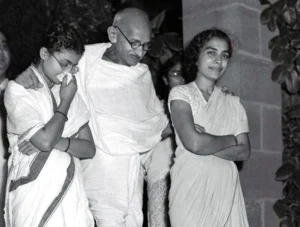
2
Gandhi made his whole life an open experiment and included in it his sexual urges too. He could not write much about it. The political problems and religious clashes that arose after the forties made it impossible for him to write about it. We can only infer from what he had said openly now and then.
Indians did not discuss much about Gandhi’s experiments with sexual urge. We do not have the tradition of discussing such issues openly. Gandhi is also a father figure for us. So, we have completely buried them. After Independence, when Gandhi was made a national identity, such debates became illegal, to some extent. Many books that discussed it, were banned.
But the Westerners discussed about his experiments with sex without any such impediments. But the problem was that they thought along the lines of the routine methodology that they apply for analysing sex. Almost all the researches were based on the sex theories of Havelock Ellis, Kinsley and the like and the psycho analysis of Freud. Till date, all of Gandhi’s experiments with sex have been discussed within these limits.
Our youth have a sacred fatherly image of Gandhi in their minds. When they sparsely learn about some researches in these books, they are shocked and disgusted and start rejecting Gandhi. They do not introspect and realize that our narrow-mindedness and falsity cause these shocks.
The approach of Westerners towards sex can be classified into two different categories. One is the Christian Catholic righteousness, its fundamental idea being ‘lust is a kind of sin’. The other is the liberalist approach which gained strength during the nineteenth century. The basic idea of the liberalists is Freudianism. They consider Freudianism as the basic simple belief that ‘if one controls the sexual urge, one will fall sick and the best method would be to let free’.
These are of no help in understanding a complex philosopher-visionary like Gandhi. Gandhi was born into the Eastern tradition of wisdom and adopted Western thinking. New possibilities that emerged from this fusion made Gandhi. At the same time, it led to many shortcomings, several confusions and complexities.
Westerners, who studied Gandhi, made his sexual plane complex to the maximum extent possible and have loaded on him him many unnecessary theories and discoveries. Today, it is not easy to approach Gandhi past those piles of words.
We can consider an incident, which Gandhi describes in his book ‘My Experiments with Truth’, as his eye-opener about sex. When Gandhi’s father was sick in his deathbed, Gandhi willingly nursed him. Once, when his father dozed off, Gandhi left for his room to sleep with his wife. It was during that time, his father breathed his last. When the servant conveyed the news by knocking at the door Gandhi was upset. He realized the place of sexual urge within human psyche.
Will the Western psychologists let go a chance like this? Here they have the two fundamentals that they require to discuss sex in a pre-established way. One is Oedipus complex – didn’t Gandhi abandon his father for the sake of pleasure? The second is guilty consciousness. They simply branded that all of Gandhi’s later experiments were based on that guilty consciousness. No research has been done to figure out this in Gandhi’s writings, readings and actions.
An important example is the book ‘Gandhi’s Truth: On the Origin of Militant Nonviolence’ by the famous psycho analyst Erik Erikson. This book, with the help of some Western psychoanalytic tools, simplifies the complex phenomenon called Gandhi. Erik Erikson ‘discovers’ that Gandhi was a confused weakling, who, all along his life, fought with his inner self, to atone a guilty consciousness.
What he wants to convey is Gandhi was a patient and had he come to Erikson, he would have made Gandhi lie down on the couch flashed light on his face, talked to him in a soft voice and would have ‘cured’ him. In Erik Erikson’s book, there is unbelievable simplification beneath the extensive theoretical researches and modern technical terms. But we also see that Erikson has approached Gandhi’s theory of Ahimsa with much creativity. Because, the Western theories are very helpful in examining something in the historical perspective. With their holistic approach we can identify the undercurrents.
Gandhi has written about this guilty consciousness. It might not have been the absolute reason for his quest. It might have shown him the disintegration of personality that lust creates and how powerful lust is. He might have understood the tradition that portrays lust as spiritual filth. It might have been a beginning.
Almost all Indian saints, who did not have a dramatic experience and guilt like Gandhi, had reached the same point that Gandhi had reached, at some stage of their development. Ramakrishna Paramahamsa, Aurobindo, Vivekananda, Vallalar, Narayanaguru – how absurd it would be to say that all of them were driven by guilt? As the next step one can even simplify the entire Indian pursuit for wisdom to be born of guilty consciousness. Actually, celibacy or renunciation of sex is an important point to which the knowledge seeker is driven by our tradition.
Generally, trying to understand this issue objectively with the help of theories and principles would turn out to be a kind of intellectual exercise. This kind of researches would surprise us and over a period create only distrust. A new theory evolves every now and then and Gandhi is analysed with that. If it was Freudianism yesterday, it is Symbolism today and it would be something else tomorrow.
We know our world of private sex. We are aware of our struggle with it and the compromises we made. It is easier to understand Gandhi with our own experience and only this would prove to be useful. We should use theories only if they facilitate such understanding.
Gandhi did not subject himself to experiments on sex because of any guilty consciousness. He took it up, as part of his various spiritual experiments. In South Africa, when he was 36 years old, he decided to practice celibacy. He had already devised for himself many severe practices such as food restrictions and daily toil.
He started practicing this only after discussions with Kasturba and obtaining her permission. He continued it, in spite of the difficulties. During this period, Gandhi did not record his observations. But one can easily guess as to what would have happened from what he practiced in later years.
Gandhi did not put in any extra effort for self-restraint. He just controlled his senses. He did not consider yoga, dhyana and tantric methods of the Hindu tradition of wisdom – he was not aware of those. He did not follow the intense prayers and control that are put forth by the Christian tradition for celibacy.
He undertook that experiment trusting his raw mental strength. That mental strength is like clinching tightly the mouth of a steam vessel with one’s hand. Gandhi’s mental strength would have been exhausted by this. Suppressed sexual urge would have gone to the bottom of the mind and become enormous. Gandhi would have been subjected to severe mental test with dreams and uncontrolled daydreams.
This happens because those who take to strong spiritual pursuit, would have more intelligence and imagination than common people. We may call it greater inner strength. More suitably, it may be called the power of life. As it holds good for sexual urge too, their sexual urge would be greater and so also their hunger.
Gandhi has written about his excessive desire for sex and food. We can see our Siddhas cursing their excessive sexual urge and calling themselves as sinners and lowly filthy. The extra power that comes from their body later comes from their minds too. We can understand this from the fact that many of our saints were fighters, policemen and wrestlers.
Gandhi might have arrested his lust by confronting it with his equally vehement ego. When the opposite force grows stronger, so does the lust. Those who have experience in meditation would know this. Gandhi would have been under severe pressure while he was in South Africa and when he came to India. He would have channelised the inner power by way of timeless public service and minimal sleep.
Gandhi’s relationship with Saraladevi Chowdarani, when he was back in India, was a peculiar chapter in Gandhi’s life. Rajmohan Gandhi, in his book ‘Gandhi: The Man, His People, and The Empire’ refers to this relationship.
Gandhi went to Amritsar and Lahore to assess the happenings in Punjab after the Jalianwalabagh Massacre of 1919. While in Lahore, he stayed with Ram Bhaj Chowdry, who was a journalist and a leader of the Punjab’s Congress. Saraladevi, wife of Ram Bhaj Chowdry, was attracted by Gandhi and Gandhi too was attracted by her.
Saraladevi was born into a wealthy family of Bengal and was a close relative of Tagore. At a very young age, she was attracted by Aurobindo and together with extremists she had participated in the freedom struggle. She was the first to sing Vande Mataram in the Congress Conference. Because of the pressure from Bengal police, she had to move to the distant Punjab, marrying Ram Bhaj Chowdry. She was a great beauty and had keen interest in literature, arts and politics.
When they met, Gandhi was fifty years old and Saraladevi was forty seven. Gandhi had four children and Saraladevi had one son. By that time Gandhi had become ‘Mahatma’, having lead the Champaran Satyagraha and the Non-Cooperation Movement. He was spearheading the Indian freedom struggle.
The mutual attraction between them was short lived. Gandhi was engaged in lengthy dialogues with Saraladevi. Later he wrote a few short letters. In those letters, he referred to Saraladevi as his knowledgeable friend. Saraladevi wrote with emotion about Gandhi’s wonderful power of attraction.
As was his practice, Gandhi was explicit about his interest in Saraladevi. After the death of Saraladevi’s husband in 1920, that attraction became more intimate. Gandhi decided to marry her, even though he was adhering to celibacy. His attraction towards Saraladevi was purely intellectual. When he conveyed his decision to marry her, his friends were shocked.
Gandhi explained that his relationship with Saraladevi had no tinge of bodily desire. He said that both of them had crossed that age and that he wanted to experiment whether the relationship between the opposite sexes could be a tête-à-tête that would lead to mutual intellectual growth. But this was vehemently opposed by his son Devadas Gandhi, Rajaji and the like. They said that it would spoil his image and dissolve the freedom struggle. It was only natural that Gandhi did not worry about all these.
Later, Devadas spoke to his father in private and explained that Kasturba was deeply hurt. Gandhi agreed to backtrack from that idea. He wrote to Saraladevi about his decision and this made Saraladevi deeply hurt. She wrote letters denouncing Gandhi.
Later, Saraladevi’s son had visited Gandhi’s ashram. Gandhi has not recorded much about his relationship with Saraladevi in his autobiography. He just mentions that he was attracted by a woman and had overcome it soon. Probably, he did not want to elaborate, as Saraladevi was alive then.
These facts have not been discussed in detail, until the publication of Rajmohan Gandhi’s book. Gandhi was never secretive about his actions. He had dictated all his letters to his secretary and all those letters are freely available.
I remember, with surprise, that I took up a single line from Gandhi’s autobiography and had argued with Nitya Chaitanya Yati about this faltering of Gandhi. This topic surfaced when we were discussing the marriage of Pithukkuli Murugadas, whose songs I had given to Nitya a few days earlier. In Nitya’s Gurukulam too there had been a similar incident. This problem often arises in ascetic monasteries and deserves elaborate discussions.
A few psychological experiences are predictable in human life. After seven or eight years of marriage, men get a sudden urge to form a relationship with other women. We are shocked when men, who are absolutely dedicated to their family and wife, suddenly go astray. Similarly, when they are in their forties and nearing menopause, there is a possibility of sexual transgression among women. Till date, this continues to be a mystery in the society.
The physiological and psychological reasons are many. Human mind is more or less a creation of the environment. It is just part of the incomprehensible system called body. Whenever a man observes his mind, he realises that it is beyond his control. So, these activities should be considered in relation to human body and mind and not to individuals.
Similar digression is possible in ascetic life too. After taking up sanyas, the ascetics, when they near their fifties suffer a wavering. Many of them have, all of a sudden, abandoned ascetic life and entered wedlock. This may rekindle your memory of such incidents.
There are so many incidents in Narayanaguru’s movement. Nitya had spoken about Mahakavi Kumaran Asan. Kerala was shell-shocked when Asan decided to give up asceticism and heirdom to Narayanaguru for the sake of marriage. Similarly, another student of Naryanaguru ‘Brother’ Ayyappan too got married. They married very young girls.
Nitya said that they gave up and decided to marry because they were very honest and were not worried about earning others’ respect or favour by creating a false image of their own. He said that though the reason for this cannot be fixed, we can speculate something. At some stage, the ascetic realizes that conjugal pleasure does not matter to him anymore. He thinks that the extraordinary attraction towards a woman is spiritual or intellectual. Nitya said that many ascetics have confided this to him.
This is the incipient nature of life. Around fifty human life starts to move towards death. When that thought affects the subconscious, the desire to live springs up. It wants to move towards youthfulness and does not want life to end thus. More or less, at this age, many men try to explore new avenues. Some change their profession, some move to a new place. There are a few who start life afresh in spheres that are absolutely new. The underlying urge for all these attempts is the same – the consciousness that ‘my life is not over; this is a new beginning; yet another life remains.’
One more aspect is Yoga that is part of the ascetic life. A problem with Yogic practice is that nothing might happen for a long time after the initial excitement and revelation. It depends on various aspects such as the personality of the ascetic, the lineage of his teachers, his approach, etc.
Normally, those who are more imaginative with logical skills, take longer to reach the second stage. With the help of their imagination they would blow up whatever they have achieved. That blown up structure itself would become an impediment to their progress.
When progress is impeded, practice of Yoga becomes a boring routine. For practicing Yoga, ascetics would make their daily life very simple. Thus, the entire life becomes a meaningless, changeless cycle. At this stage, the above attractions gain momentum.
When these three causative factors combine together, the psychological problems of the age of fifty emerge. Many ascetics are intensely attracted by some woman. They are shaken by the intensity of that experience. Like a forceful river, it spins and carries them away. They abandon themselves by that force. Very few of them withstand it. At this age, ascetics get into familial ties and vice versa.
With a smile, Nitya referred to another phenomenon. It can be seen that the women, the middle-aged ascetics marry are not ordinary ones. They are extremely beautiful and intellectual. They are the best among women. Any young man would die for them. Why are they attracted towards these ascetics? In many instances, the woman would have proposed to him; hooked him towards her.
When a woman, who had thus married an ascetic, asked Nitya whether her action was wrong, Nitya had said, “It was not your doing. It was your womb that did it.” And this happens only to the best among the ascetics. Their extraordinary inner power and the resultant personality attract women and they pose a challenge to them.
Imaginative and intellectual women never get attracted much by a man’s physique or youthfulness. They are always attracted by a man’s personality. Only a man’s inner strength attracts them. It is the desire of the life that is functioning within them. It can be simplified as the biological desire to pass on the best traits of the race to the next generation. The desire to have a child like the man she adores emerges as her subconscious desire.
Moreover, it infuriates her ego. Conquering man is a natural desire of the woman’s personality. Conquering the unconquerable man is the challenge to the best of women. Though she is not aware of it, that magnetism finds place in her body and speech. Banumathy Amma’s personality would have been incomplete, had she not married Mahakavi Kumaran Asan. Rarely, this desire might end up in enslavement and humiliation.
Nitya would say that this was what exactly had happened to Gandhi. Gandhi was adhering to celibacy only on his mental strength and without any practice of yoga. He thought that he had outdone lust because of his ability to practice celibacy for nearly fifteen years. He might have thought that lust was just physical desire that was not needed. And he might have imagined that he had overcome it.
But a man needs a woman not just to satisfy his sexual urge. Her place as a friend is more significant. Lust is not just sleeping with her, but that friendship too. To Gandhi, Kasturba was just a dedicated wife. Intellectually she could not be his friend. Gandhi, who had a fine sense of humour and a keen interest in intellectual discussions, could not have considered Kasturba as an equal.
So, Gandhi might have been fascinated by Saraladevi, who had extraordinary sensitivity, intellect and sense of humour. Gandhi says that his discussions with Saraladevi were on a much higher plane. That is why he imagined that it was not lust. He might have thought that such a friendship with a woman sans sex would suit celibacy. He tried to marry Saraladevi only because of his longing for permanent companionship with her. There was every possibility of Gandhi getting caught in the trap of the age of fifty, which the ascetics fall prey to.
But at some point, as a bolt from the blue, Gandhi would have realized that it was only lust. We find from his autobiography that he felt sorry for this wavering. Later he had discussed it with Kasturba. Kasturba was a typical Hindu wife of that period, who followed her husband with patience and understanding. It was her misfortune that she had to be the wife of an uncontrolled hyper sensitive man like Gandhi.
This experience appears to have made Gandhi realize the limitless power of lust. His book ‘Experiments with Truth’ ends somewhere here. What happened in his private experiments afterwards is not known to us. But from his other writings during this period, we are able to observe a significant change in the mindset of Gandhi.
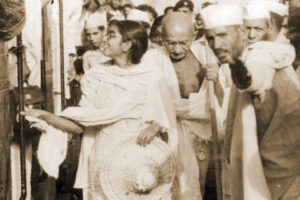
3
Gandhi had always understood Ahimsa and celibacy as linked with each other. This understanding was influenced by Srimad Raj Chandra who was known as Kavi Raichand. Young Gandhi, when, after his education in London had returned to India and was trying to settle down as a lawyer in Mumbai, was introduced to Raj Chandra by Dr. Braj Jeevan Das.
Raj Chandra Mehta, a Jain scholar, who was later known as a sage, was born in Rajghat. The letters that Raichand wrote to Gandhi, which took the form of spiritual discussions, are very famous. He was attracted by Jain ideologies at a very young age. He was well read and though had an ascetic attitude, he did not quit his family. Raichand died at the age of 34.
Raichand was a jeweler. He was an expert in valuing rare gems. The turnover of his trade was several lakh rupees a day. Gandhi observed that he had an extraordinary spiritual strength and was good at multi-tasking. Gandhi put him to severe tests. Raichand could repeat the verses and legal phrases that Gandhi would tell, with so much ease though he had never heard them before.
Their discussions slowly turned spiritual. Raichand had a keen interest in the fundamental principles of Jainism. Gandhi received his first key to knowledge from him. Vegetarian food, nature therapy and the like, in which Gandhi was interested while he was in London, all perfectly fitted with the ideas of Raichand.
Gandhi says, ‘I was bored meeting various religious leaders. I had totally lost interest in discussions on religion. But the speech of Raichand enticed me. No one had attracted me as Raichand did. His words hit me directly.’ The ideas inculcated by Raichand persisted in Gandhi till his end.
Raichand told Gandhi that Ahimsa is not just non-violence. Ahimsa cannot be separated from truth and celibacy. Ahimsa cannot be attained without overcoming desires, as all torments result from desires. Lust is the foundation of all desires. One who controls lust can easily conquer other desires. One who conquers desires, attains Ahimsa. Ahimsa is the only path to truth.
Throughout his life, Gandhi was saying that celibacy, Ahimsa and truth are one and the same. He argued that those who were leading the national struggle through Ahimsa have to practice celibacy. When disputes arose about his sexual experiments, he said that he was conducting those experiments only for the sake of truth. He affirmed that he will face any opposition for the sake of truth.
But it appears that Gandhi, during the last years of his life, was allured by the Bengali Tantrics. There are brief references in his autobiography about some of the Tantrics he had met. Kathryn Tidrick in the book ‘Gandhi: A Political and Spiritual Life’ states that Swamy Anand and Kedarnath might have known about Gandhi’s Tantric activities. But, not much is known about them. Gandhi was close to Bole Baba, who was a Tantric. Gandhi had sent his son Ramdas on an Himalayan expedition with him. This side of Gandhi is not widely known.
To be fair, Gandhi’s Western thinking would not have approved of Tantra. There is a serious contradiction between Tantra and Jain and Christian philosophical fundamentals. Gandhi was totally against Brahma Gnana Sabha, etc., which believed in Tantric principles. But we cannot conclude anything about a strangely crazy person like Gandhi.
Here is a simple explanation on what Tantra is. Tantra is a tradition that has evolved from the ancient Indian tribal worships. Later it combined with philosophy and major religions and grew in all directions. All over the world, there exists among the tribals, some kind of practice similar to Tantra. The word ‘Tantra’ is very ambiguous. All the rituals that a wisdom seeker performs for self-improvisation are collectively called Tantra.
In the modern scientific language, we can define Tantra as ‘Training the subconscious and enhancing its strength with symbols and symbolic activities’. The subconscious mind is capable of absorbing the symbols easily and multiplying them. Symbols have direct dialogue with the subconscious. Thus, ancient people found out that the subconscious could be controlled as wished for with the help of required symbols. Their idols of God and various rituals of worship had evolved through experiences for this purpose.
Following that method with philosophical clarity and with specific objectives is called Tantra. Tantra has been closely observing the symbolic activities and keeps on improving them. In due course, it took the form of a separate tradition. Major religions such as Saivism, Vaishnavism and Saktham, as a result of the intrusion of Tantra, gave way for new branches. Buddhism interacted with Tantra and gave birth to Vajrayana Buddhism. Buddhism that spread in the East Asian countries is an extension of Vajrayana.
Tantra was never meant to be practiced by everybody. It is for those who pursue it seriously. It is meant for him, who is prepared to sacrifice everything to attain the truth lying within him. It permits any action for the sake of that search. It was said that it can overlook evil, righteousness, virtue, compassion and the like. In Saivism there are many divisions like Kalamukas, Kapalis and Ahoris.
Tantric tradition has contributed a lot to arts like painting, architecture and sculpture. Most of our temple sculptures were symbolic forms created by the Tantric tradition. Tantra has greatly influenced our temple architecture too. Even our religious rituals were formulated based on Tantra. Many symbols like Sri Chakra and Meru are absolute inventions of the Tantric tradition.
After the tenth century, Tantra started losing the importance given by Saivism and Vaishnavism because of the Bhakti movement, which took religion to the commoner. It transformed the religion into arts and literature, into celebrations, temple and religious festivals. It converted philosophical ideas into simple epics (puranas) and rejected Tantra completely. In many places, Tantrics were chased away by the pioneer saints of the Bhakti movement.
Bhakti movement changed the procedures of the Tantric rituals and converted them into worship rituals. Many of the rituals that we follow today have their roots in Tantra. Breaking a coconut, offering betal nut and the kumkum are some of them.
Saktham was the only religion that retained Tantra and remained unaffected by the Bhakti Movement. Saktham was deeply rooted in Bengal and Kerala and to some extent in Orissa. Even today, the temples of these regions perform puja in the Tantric way. Though Tantra has slowly lost its originality and has become just a ritual, it has its place in India.
Tantric way to knowledge is precisely defined by Osho as ‘Overcoming by awareness’. To conquer something you have to be aware of it. By avoiding something, we remain ignorant about it. Ignorance creates fear and we become slaves of what we fear. We become the lord of what we are aware of.
But those who indulge in enjoyment for the sake of knowing do not gain those experiences. They remain within the experiences. So, experience with detachment can only become knowledge. That is experiencing only for the sake of knowledge. It is trying to be aware of the sexual urge by absolute self-restraint. There, knowledge becomes a symbolic experience. Thus, Tantra unfolds many symbols.
There are two main divisions in Tantra – Vama Margam (The Left Way) and Dakshina Margam (The Right Way). Vama Margam is utilizing symbols directly. Five ‘M’s are essential in its rituals – Madhu (Wine), Maamsam (Meat flesh), Maavu (flour), Mantra (chants) and Maidunam (sex). Vama Margam makes man to face his weaknesses and cut them with a sword. So, it is called a ‘sword soaked in blood’.
Dakshina Margam sublimates the symbols and uses them at a finer level. Vama Margam offers blood. Dakshina Margam thinks that pumpkin and chenthooram would suffice. Its symbols and codes are more poetic and subtle. Dakshina Margam is called a ‘sword of gold’. Vama Margam, as the name suggests, was popular in Bengal, which is on the left part of India. Dakshina Margam, true to its name, was popular in South India.
Prof Nick Gier, who later analysed Gandhi’s experiments with sex, in his book ‘The Virtue of Non-Violence: From Gautama to Gandhi’, says that Gandhi might have adopted some of the rituals of the Dakshina Margam, to suit his ways.
Actually, there are no rule books or definite methods for the rituals of Tantra. They are designed from time to time in accordance with the customs of those Gurukulas. There are thousands of tantric practices spread all over India. Tantrics maintain secrecy and so, they are not publicized. From Arthur Avalon to Akekanandabharathi, the Western researchers, who wrote about Tantra, have described it based on the second rate Tantrics who were ready to converse with them.
Around 1936, Gandhi started the experiment of Sahasayanam (sleeping alongside women). Sometimes, he had women on both his sides. They were young women who lived in his Ashram. For nearly ten years Gandhi practiced this. Initially this was termed as part of his nature treatment. Later, when criticisms arose, it was explained that he was doing so to test his celibacy. But, Gandhi did not explain it clearly. Thus, it still remains a mystery and a reason for speculations, slander and abuse.
Gandhian researcher Bhikhu Parikh in his book ‘Colonialism, Tradition, and Reform: An Analysis of Gandhi’s Political Discourse’ analyses these experiments of Gandhi. Nagarjunan has translated some parts of this book into Tamil.
Bhikhu Parikh says, from 20th December 1946, Gandhi and his granddaughter Manu started sleeping alongside with no clothes on. Gandhi ordered Manu to write about this to her father. He further said that Manu should write down her opinion in a notebook everyday, show it to him and get his signature on it.
The notable aspect here is that Manu took part in these experiments overtly, fully knowing what she was up to. It is meaningless to say that Gandhi exploited Manu and other women. None of them suffered from any mental problem later. Their lives were spiritually satisfying.
After three weeks of starting this experiment, on 8th January 1947, Gandhi has referred to this in his letter to his friend Krishnathaj Thanji. Gandhi remarked, ‘This is a severe test, but very much useful’.
Till then, Gandhi’s experiments were not known much in the public. During this period, they gave rise to controversies and were severely criticized by the followers of Gandhi. Bhikhu Parikh says that all, including Nehru and Patel, were deeply aggrieved by this.
Some aspects of this action of Gandhi are noteworthy. Firstly, Gandhi was not secretive about it. He was so candid. The room in which he lied down alongside women had no doors and was accessible to all. Secondly, those women were orthodox. Nobody found any fault in it. In fact, they were shocked, when this became a scandal later.
Today, some, especially feminists, say that Gandhi did not take into consideration the feelings of those women. But, in fact, those women mention it as a perfectly natural action. Susila Nayyar, who had lied alongside Gandhi has said “Gandhi Bapu called it a natural treatment in those days. We would lie on his back. Bapu would fall asleep immediately. I could not understand, then and now, what was wrong in it.”
Western researcher, Nick Gier, who had written about this, has recorded that it was only with Gandhi that the women in Gandhi’s Ashram had a natural relationship without any sexual embarrassment. Manu had said that when she lied alongside Gandhi, she felt as if he was her mother. It is notable that she did not say ‘father’. No sexual act or disturbance in Gandhi had come to their notice. Thus, when he himself said that he was sexually aroused twice, Manu got confused a bit. Till the end, Gandhi had been like a mother to her.
Here, we should also note that when Gandhi embarked on these experiments, he was sixty. Through rigorous fasts, he had contracted his body. Twice he was on the verge of death due to fasting. He observed silence. His body became lean and dried and took the form that we have in our mind today. But he was physically very strong and active. He slept little. Apart from prayers, he practiced meditation everyday for more than an hour.
During this period, he did various experiments with food and self- medication. Most of it appears eccentric to me – one was taking enema daily and that too with salt water. It was absolutely wrong. It will make the bowel defunct. Another was drinking a glass of urine firstly in the morning. This too was absurd. There is a system recommending urine as a medicine. But, even according to that, drinking the urine that contains excessive urea resulting from fasting, is idiotic. Every day he observed his feaces and made notes. He experimented with his body, in his own way. What he did was known only to him!
Gandhi’s experiments on sex always drew criticism within the Congress. He did not mind them. In 1946, during his final days, when he undertook the Navkali Yatra in Bengal, Nirmal Kumar Bose, his Bengali translator was shocked to see Gandhi sleeping alongside women. He questioned Gandhi directly and was not satisfied with Gandhi’s reply.
In 1953, Bose published his book ‘My Days with Gandhi’, on these experiments of Gandhi. It created much sensation. It was during this period that these experiments were extensively made public. Though the sensation of this book died down early in India, it attracted much attention in the West. Similarly, R.P. Parasuram, who was Gandhi’s private secretary, resigned when he saw Gandhi sleeping alongside Manu. His interviews too became controversial.
But, by then, Gandhi had been assassinated. His final years and death earned Gandhi the place of a prophet. Amongst the people who were clashing and dying due to religious enmity, Gandhi was wandering in the streets with the message of love and Ahimsa. Those were the most sorrowful moments of his life. Gandhi saw his beliefs in man’s good nature ruining in front of him. Yet he believed in man’s soul. He refused to lose his faith in Ahimsa.
More than that, those who were calling him Mahatma till then, started abusing him. They started hating him. Gandhi believed that as a Hindu, it was his responsibility to stop the Hindus from killing the Muslims, even by risking his life. But the Hindus raging to avenge called him a religious traitor. They told him, ‘Muslims are killing and raping innumerous people. Go there and preach them your Ahimsa.’ And Muslims considered him just a Kafir.
During that period, everyday, at least a hundred people, cursed Gandhi to ‘die’. Even those who loved him wanted him to abandon politics and become a Sanyasin. Gandhi’s mind was shattered. He had started feeling strongly that it would be better to die and he had said so. But he did only what his soul approved.
Surprisingly, even at that stage his self-dedication worked. All historians and journalists have recorded this with awe. He was able to bring peace wherever he went. Every day, thousands of people gave up violence for his sake. They took the oath of brotherhood. Even the pro-white press that strongly criticized him, called it the ‘Gandhi magic’.
Because of frequent fasting, Gandhi had become very weak and could not even walk. Without anybody’s assistance, except Manu’s, who was of the age of his granddaughter, he toured Navkali which was rife with murders and riots. Manu, who accompanied him with trust, had no fear. She felt as if she was with her mother. Gandhi was 77 years old, an old man ripened in all aspects. It was during these days that Nirmal Kumar Bose saw Gandhi sleeping alongside Manu in the open.
The fact that this scene had shocked Nirmal Kumar Bose calls for some thinking. I think that his mind might have been shrouded with negative morality. That is nothing but Victorian moralistic fundamentalism. Even today, the mind of majority of Indians is ruled by that dark morality.
Nirmal Kumar Bose has written his book in that state of mind. While commenting on that book, Susila Nayyar says, Nirmal Kumar Bose’s mind is tainted. Yes, the taint of ignorance. That is why this scene had appeared more important to him than the grossly painful drama of Navkali, which was similar to the journey of the Christ preceding crucifixion.
In fact, Nirmal Kumar Bose had no doubts about Gandhi’s intentions. Bose says, “There was no violation of morality on Gandhi’s part. He tried to overcome lust by consciously becoming a women and a mother. With this intention he made them, whether men or women, sleep alongside him.”
Later, Ved Mehta, in his book, ‘Mahatma Gandhi and His Apostles’ wrote about these experiments of Gandhi with sarcasm. English writers like Nirad Chowdry, Ved Mehta, V.S. Naipaul and others, tried to ‘civilise’ themselves by becoming British. To them, India was just a funny dark continent. Their readers too wanted this fun in their writings. With his contracted mind, Ved Mehta could not handle such a subtle thing and his baseless literary world could not withstand this.
How should we interpret these experiments of Gandhi? Today’s reader would find his modern day ethics being harshly provoked by these actions of Gandhi. I too was thus provoked when I was very young. But I had teachers with whom I could discuss it elaborately. Slowly, I was able to move towards clarity. It is not possible for everyone.
And the contemporary superficial Bhakti tradition has inculcated in us an image about saints. We believe that they are not made into saints but are born as saints. Even while writing about ordinary ascetics or seers we write about the greatness of their incarnation. We are not informed of spiritual struggles and quest. We consider Gandhi as one among them. Hence, these kind of information would only shock us.
This is a plane that has to be approached by moving past simple imageries with a mindset to realize truth. We can simply reject Gandhi here if we want to. But, to understand him, we need to move forward.
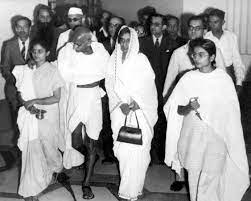
4
Today, all those with a reading habit would have their own idea about the experiments that Gandhi did by sleeping alongside young women. Most of them would be their observations and not analyses. Because a very few Indian writers have the required philosophical background to go into the issue and analyse elaborately.
Nitya Chaitanya Yati said, ‘Gandhi’s practice is called ‘Sahasayanam’ in Tantric tradition. It is a way in Vaishnavite Tantric tradition. It is said that Krishna performed it with Gopikas. It can be defined as ‘entrancing the senses to conquer them’.
There is a story about this. When Vyasa was standing near the boat jetty on the shore of Ganga, Krishna came and ordered “I, who renounced the senses permanently, have come. Give way”. Ganga gave way. Only a little while before had Vyasa seen Krishna playing amorously with the Gopikas in the river. He was surprised. When he asked Krishna about this, Krishna replied, “When the soul is not involved, the senses feel nothing. Senses are only the gateways of the soul”.
This practice existed in the Buddhist Tantric tradition and in Zen tradition too. The novel ‘The House of the Sleeping Beauties’ by Yasunari Kawabata, is a proof for the existence of this practice in the Japanese Zen Buddhism and its transformation into a method of treatment. In the novel, old men are made to sleep near young women. It is a belief that it will increase their life power. Those women come for a fee and would be sleeping with the help of sleeping pills.
Tantra’s Dakshina Margam has two methods. They are generally called sadhana and upasana. They are also called upasana and vipasana. Indulging in symbolic rituals may be called sadhana. The word sadhana means practicing. vipasana means knowing as it exists. There are many rituals in this.
Generally, upasana is the method of Dakshina Margam. Upasana means ‘sitting beside or sitting equal to’ (upa + asana). It can be termed as sitting on par with the worshipping deity. It is just a pretence called bhava. As this bhava is closely associated with Bhakti, Dakshina Margam in Tantra is almost intertwined with Bhakti. The bhavas of the Dakshina Margam have been simply adopted by bhakti.
Antony Parel observes that Gandhi, in his entire works, has written the maximum under three topics – celibacy, untouchability and Gram Swaraj plans. Only these posed more and more challenges to Gandhi. Experiments with celibacy take the first place.
There are two notable aspects in the letters that Gandhi wrote after 1932. One is, he had started imagining himself as having femininity and as a mother. In many letters he refers himself as one. He believes that attaining femininity and becoming a mother is spiritual maturity. Gandhi says, ‘woman is weak in attacking but boundlessly strong in tolerance’ and adds that is the apt form to practise Ahimsa. He writes in a letter that he has slowly attained femininity and has become half-woman.
Gandhi, in his letters of this period, also uses two imageries – a gruesome mother and a power-embodied mother. It appears that Gandhi did not want to reveal these imageries that were within him. But it has come out in few of his lines, without his knowledge. Since Gandhi had the mind of a western modernist, those lines stand apart and are prominently visible. For example, when he spoke on the radio for the first time, he calls it the Leela (play) of Mahasakthi.
Both the imageries of loving mother and killing mother are directly related to Tantra. They are the two ways to conquer lust. At the same time, they are interrelated. For a male, it is a great freedom to lose the masculinity in his soul. He becomes free from his the forceful and authoritative lust. He conquers the violent elements that are unique to a male.
Motherhood is both caressing and consoling. It is compassionate and expansive. When motherhood becomes the attitude it can expand encompassing the whole world. It can be said that motherhood is the peak in human spiritual stages. Tantra tries to move towards this through various practices.
The Vipasana method has adopted the pretence of ladylove (nayaki bhava) as a beginning to achieve the motherly feeling. Forgetting one’s own personality and surrendering totally to the ideology of Lord is Nayaki Bhava. It is falling in love, longing for the beloved and enjoying the sublimation of expression of all subtle feelings. The next stage of development is the pretence of motherhood.
In the hymns of Nammazhvar, we see these two Bhavas expressed so beautifully. We see this in Bharathi too. This Vipasana method might have gone to the West from India. In Solomon songs, in the Old Testament of the Bible, there are precedents of Vipasana. They always existed in Central Asian and European Christianity.
After the emergence of Roman Christianity, Vipasana method continued to be present in the Baptist Christian tradition. They combined these with fasting, hermitage and similar severe practices. Through the saints like John of the Cross, Upasana methods like Nayaki Bhava slowly entered Catholic Christianity too. Initially the Catholic Church dealt with the Baptists harshly. But the strong importance of these expressions in the Bhakti movement slowly established them.
These expressions have always been deeply rooted in India. We see this in the works of Sufis like Kunangudi Masthan Sahib and the Christian seers like Veeramamunivar. It is said that Ramakrishna Paramahamsa physically became a woman through Vipasana. Historians write that breasts developed in him. A great part of Ramalinga Vallalar’s songs is based on Vipasana. The emotions of many songs have not yet been completely understood.
Gruesome mother too is an imagery for controlling lust. Surrendering as a child to the mother, who is capable of punishing and compassion, is the Upasana method followed here. This paves the way for dissolution of ego and thereby control of sexual urge. When one pretends to be a mother and the child concurrently, the dialectics or the Yin-Yang creates wholeness.
Only when Gandhi became interested in the practices of Yoga, during his final years, did he indulge in things like sleeping alongside women. For this he did get the permission of Kasturba. His grownup son Devadas was also living with him in the Ashrams. It cannot be said now, whether Gandhi really was involved in Tantric practices or whether he altered some tantric practices according to his imagination and tried them out. Psychologists generally believe that the latter might have been the case.
The article ‘Modern Father who wanted to be the Ancient Mother’ by Jamaalan is an important attempt which tries to analyse this issue with the theories of new Western body politics. His perfect and beautiful title itself points out the important contradiction in Gandhi. He wanted to attain motherhood, but his mind was shaped by the logics of modern Western thoughts. This was Gandhi’s problem.
How to evaluate Gandhi’s practice of celibacy from today’s angle? It is true that in the eyes of an ordinary man, there is a discordant note in it. Indian society’s modern psyche is made up of Bhakti movement and by the Victorian morality given by Western education. Both completely reject Tantric practices. Thus, it is natural that an ordinary Indian psyche did not accept these actions.
I am a descendent of Narayanaguru’s tradition. Narayanaguru, during his early days, socialized with Tantrics. Later he renounced Tantra and moved towards pure Advaita. Even in Yoga, he accepted only Pathanjali’s pure Yoga and not the one created later with symbolic practices by the Tantrics. In Narayaguru’s tradition, Tantra is completely banned. So, it is unacceptable to me too.
Yet, Nitya Chaitanya Yati, never denied the existence of Tantra. It has been prevalent in this land for thousands of years and it will continue to exist. This is the only land where it can survive. So, Nitya said, there should be a place for it here. If not here, it will have no other place in the world. Then, he said, there can be no research on human possibilities and new horizons of spirituality.
For example, there is an international Tantric institution called Siddhashramam that has its headquarters in Thalachery. They are an exclusive society within which men and women live together without marriage. Within the boundaries, they do not wear any dress. As male and female children are separated from the parents and live without any familial relationship, there is the possibility of sexual relationship between brother and sister, mother and son.
From the eighties, Marxist Communist Party of Kerala has been perpetrating severe attacks on Siddhashramam. While referring to the violent attacks in 1994, Nitya said this. Siddhashramam can be termed as a human laboratory for a new kind of life. As long as their experiments did not affect the life of the general public, they should be allowed. That would be democracy, said Nitya.
The attitude of believing that only the generally accepted morality is the true morality and all others should be eradicated is Fascism. Marxism started in the West in this way, i.e. living together in groups and hence the name communes. Islam and the Catholic religion put forth a general morality and try to suppress all others. The communists treading this path, Nitya said, only shows the philosophical deterioration of our society.
The society that suppresses the unusual with the average is a Fascist society. The society that provides for unusuals at all stages is the real democratic society. For centuries, with few exceptions, India has been one such society. This is the land where various beliefs, religions and clans lived together. Thus, this has been the place where various experiments were conducted.
The best example is Silappathikaaram. We see in it an environment where all religions coexist with mutual exchanges. All religions are considered equals. Kovalan worships in the temples of Siva, Vishnu and Buddha. Yet he is a Jain. On his way, he stays for a few days in a secluded village like Siddhashramam, where Brahmins live singing lustful songs. That is Indian civilization!
But, in India, of late, in the name of democracy, the voice of the average is raised against special values. In the eighties, Anandamargis of Bengal were violently suppressed by the Bengal Government and the party. The ashrams of Osho were abused and made almost defunct. Meivazhichalai in Tamil Nadu was suppressed by the State Government. No kind of crime was found in any of these.
Even then, they were pictured as criminal groups by the Government, the political parties and the media. Common people easily start disliking these groups just because they are secluded and unusual. People will believe any kind of story cooked up about them. In the name of democracy and the people, we are moving towards the mindset of religious fanatic governments of the medieval period.
The society which gives room for idiosyncrasies that do not clash with the common society, is a healthy one. There will be a place in it for individual quest for knowledge, spiritual quest and expression of arts. That society will keep trying at self evaluation and to steer itself in new directions.
For centuries, India has been like that, as the main religions of Hinduism, Jainism and Buddhism here do not put forth collective average spirituality. They do not advocate a single way to everyone. They stress that every individual should find his spiritual uplift in his own way. That is why Saivism, which worships Lingam as the main deity in all big temples, includes in its fold Ahori, who sits on the Lingam for meditation. It says, one who offers a corpse to Siva is also a Saivite.
India would be in ruins, if, for any reason, the nation and the Hindu-Buddhist-Jain religions lose this great heterogeneity. If India becomes a finely chiseled society like the Catholic, the Islamic or the Communist-centred societies, then it will no longer be India.
The Indian psyche with its modern education is very much disconnected from its cultural roots. It considers the morality that is taught in the schools as the only way of life. It is unable to understand the various ways of quest for knowledge. This is the reason for the primitive acts of stoning a naked Jain. We are able to accept a liberal action, only when it is explained with American liberalism. Our modern intellectuals, who despise a Tantric group would casually accept a treatment centre which prescribes nudity.
We have to understand Tantra and the like in our traditional background as they are inseparable from our tradition. We do not know what actually they are. The only way to understand them is to plunge into them. But it is not possible for everyone. Are they really useful? Why do they survive? Our common sense does not understand these. Thus, as long as they are not detrimental to our common society, they should continue in our society.
Otherwise, the losses that we may incur will not be ordinary. Many of the great personalities of our tradition had a Tantric background. Ramakrishna Paramahamsa had practiced Tantra in his young age, as advised by a lady guru named Brahmani. Till the end, Aurobindo was involved in Tantric practices. Narayanaguru and Vallalar had gone through it. Bharathi and Mu. Thalayasingam were interested in it.
Not only in India, but in Western countries too, a section of geniuses were involved in their Tantric practices. Leonardo Da Vinci, Mozart, Newton, Waltair, Rousseau – if one rejects them, half of human thinking should be thrown away.
Kanyakumari district is the land of Tantra. Even today, Tantric traditional worship is followed in the temples here. I have witnessed some Tantric rituals. I have spoken to many Tantrics. I had almost gone to the extent of taking preaching from a Tantric. But, till now, I have no belief in its utility. I cannot understand the state of mind that is behind its rituals. But, as it is not my cup of tea, I will only move away from it, but would not hate or reject it.
Nehru commented, “He ( Gandhi) can think only at the sublime level, whether it is lust or divinity”. That is common to extraordinary geniuses and sages. Their path is unknown to us. So, we find it difficult to understand them and that is why we crucify them.
If you want to have geniuses, you have to accept their eccentricities and idiosyncrasies. Though half of the population of Tamil Nadu considers him a father figure, E.Ve.Raa. went to the nudity camp and published his nude photographs because of the same attitude. He would not have minded even if posters of those photographs had been pasted on street walls. Only men belonging to Dravidar Kazhagam would be shocked. E.Ve.Raa. not only desisted from bathing for months but also contended that it was not necessary at all.
Gandhi’s sexual experiments or practices of celibacy were formulated by himself along the lines of the rituals of Dakshina Margam. It appears that they were not of much use to him. Raihana Tyabji, a Dakshina Margi, who was close to Gandhi, has discussed about this elaborately. Tyabji says that Gandhi mixed the Vama and Dakshina Margam as per his whims and fancies and his attempts did not bear any fruit. Gandhi did not pay any attention when Tyabji pointed it out.
Tyabji, in his book ‘The Heart of a Gopi’ speaks elaborately about all the practices of Dakshina Margam that Gandhi tried. When there is no information about the extent to which Gandhi took these, there is no point in any guesswork. He entered into a tradition that had a very long cultural background. But he had no proper guru. It is dangerous to undertake any subjective experiments without a guru. It is like starting on a journey in the desert without a map. Gandhi got involved in it simply believing in his logic and intuition. That was his first mistake.
The second mistake was the result of the first. If he had had a guru belonging to Dakshina Margam, he would not have agreed to Gandhi’s explicit involvement in those practices, while still being in public life. It is not there in the two thousand years of Indian tradition. Tantra is always secretive. The reason for the secrecy is that many of its aspects cannot be logically explained to others and justified. And except with a lady consort (Sahayogini), Dakshina Margam does not allow any experiment. The failure of Gandhi’s experiments lies in the fact that he incurred the opposition of many.
But Gandhi was ruthlessly stubborn in his own way. In his letter to A.V. Thakkar on this issue, Gandhi wrote, ‘This is not an experiment. This is an inseparable part of my Yagna. An experiment may be abandoned. Can we dump a duty?’ When Thakkar said that by his actions like sleeping alongside Manu, Gandhi may be alienated from the present, Gandhi answered, ‘I am not modern in the way you expect. I am a conservative as you imagine. Till the last moment of my life, I will remain so.’
In another occasion Gandhi wrote, ‘In seeking truth, I will be ready to sleep with thousand women.’ He said, ‘even if the entire world rejects me, I will be firm on what is true to me’. When he slept alongside his granddaughter Manu, he asked her to inform her father about this.
Gandhi tried to experiment an Eastern tradition with the Western method. Had Gandhi had a worthy Guru, he would have dislodged the Victorian morality from within him, before embarking on the Yoga Sadhanas. Gandhi’s mind was research oriented and it approached everything objectively. So, descending to the subconscious was not a simple task for him. I think, the Indian Gurukula tradition would have allowed him to enter into Yoga, only after putting him through lengthy symbolic meditations, to bring him out of the rigid frames of customs.
Gandhi’s extraordinary self-confidence gave him the courage to explore an area unknown to him. By doing this he just confused the simple minds that were with him. I consider Gandhi’s celibacy or Yogic practices as part of his own eccentricity. When I think of him, I will take these into account too. At the same time, I would consider it mean to reject or hate or ridicule him, based on these.
Gandhi’s self-treatment method too, though less shocking, was his personal madness. As it proved fatal to none, we ignore it. There is nothing wrong in Gandhi’s analysis of his own medical theories. But he, while progressing, did not take into account the developments made in those fields. Unaware of the extensive systems of medicine like Ayurveda in this country, Gandhi started with the books of novice European practitioners of nature medicine and proceeded.
His stupidity can be seen, to some extent, in his dream about Gram Swaraj too. Nehru could spot only that aspect in it. But, it is that very stupidity that enabled Gandhi to go beyond his times. He prophesied the politico-economic possibilities that none of the political experts of his times could foresee. If we can ignore the eccentricity in his ideologies and think ahead, the idea of Gram Swaraj is one of the greatest politico-economic visions of the last two centuries.
I accept Gandhi with all his eccentricities. We have no other go, as history gifts us the sages and geniuses only in this fashion.
Jeyamohan
From the Tamil book InRaia Gandhi (Gandhi Today)
Translated by Srinivasan

